Bloomberg's Leah Nylen reported Thursday that "a Colorado judge issued an order temporarily blocking the proposed $25 billion merger of Kroger Co. and Albertsons Cos., which has been challenged by…
Freezing Temperatures and Snow Bring Harvest Challenges
Late last week, Bloomberg writers Brian K Sullivan and Ashley Robinson reported that, “A large snowfall is set to sweep out of the Rocky Mountains later this week, bringing snow by the foot across the Dakotas, slowing wheat harvests and ending any chance for still-maturing corn crops to flourish.
“A foot (30 centimeters) or more will fall from southwestern South Dakota across central North Dakota Thursday into Friday, said Don Keeney, a meteorologist with Maxar in Gaithersburg, Maryland. The storm will eventually push into southern Manitoba in Canada, where it could affect canola harvests.”
Expansive area of Freeze Warnings (purple) now in effect from Wisconsin into portions of Illinois, Iowa, Nebraska, Kansas, Missouri and into the TX Panhandle. In a season with widespread spring planting delays, the growing season comes to an early end in many areas tonight. #agwx pic.twitter.com/S2sM00vs95
— Andrew Pritchard (@skydrama) October 11, 2019
Shared earlier today with clients, this is an important map considering this weekend's weather. This is the amount of consecutive hours below 32°F during the cold snap.
— Ed Vallee | Empire Weather LLC (@EdValleeWx) October 14, 2019
Note borderline freeze conditions east and long duration, hard freezes west. #Harvest19 #oatt pic.twitter.com/O8IALgaWXb
10. So, if I had to give one number, I would say we likely lost 250 million bushels of corn production to the freeze. And that does not consider snow/wind damage in the blizzard areas, which has to add further to the damage. How much more? Really hard to say right now. pic.twitter.com/R9JVQbfv48
— Scott Irwin (@ScottIrwinUI) October 14, 2019
DTN writer Russ Quinn reported on Friday that, “DTN Senior Ag Meteorologist Bryce Anderson said the Northern Plains are seeing what could be a record-breaking winter storm. The storm began Thursday and will continue through early Sunday. On Friday morning, blizzard warnings were out for North Dakota.”
The DTN article noted that, “Heavy snow from this week’s winter storm isn’t the only challenge the Northern Plains is dealing with.
“Anderson said this year South Dakota has had anywhere from 33 to 42 inches of precipitation, which is mostly 12 to 20 inches above normal. In percentage terms, this is 150% to 300% of normal.”
Here is a collection of the storm total snowfall reports we received through 7 AM CDT Sunday, October 13th, 2019. #NDWX pic.twitter.com/8MOG7JVZwG
— NWS Bismarck (@NWSBismarck) October 13, 2019
Meanwhile, Adam Belz reported in Friday’s Minneapolis Star Tribune that, “The snow and freezing conditions forecast for parts of Minnesota have farmers heading into an uneasy weekend.
“Heavy snow expected in the northwest corner of the state will delay harvest of all crops there. And in the rest of the state, a late harvest was already a given and may become even later.”
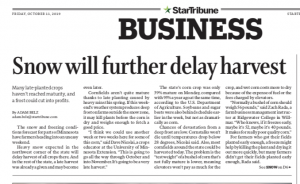
“Cornfields aren’t quite mature thanks to late planting caused by heavy rains this spring. If this weekend’s weather system produces deep frost on farms outside the snow zone, it may kill plants before the corn is dry and weighs enough to fetch a good price.”
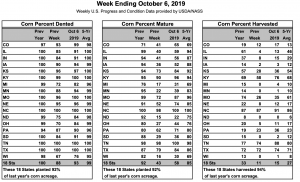
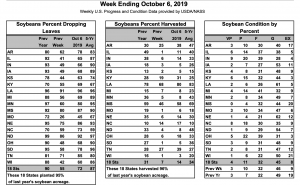
The Star Tribune article noted that, “Chances of devastation from a deep frost are low. Cornstalks won’t die until temperatures drop below 28 degrees, [Dave Nicolai, a crops educator at the University of Minnesota Extension] said. Also, most cornfields around the state could be harvested today. The problem is the ‘test weight’ of a bushel of corn that’s not fully mature is lower, meaning elevators won’t pay as much for the crop, and wet corn costs more to dry because of the expense of fuel or the fees charged by elevators.
“‘Normally a bushel of corn should weigh 56 pounds,’ said Zach Rada, a farm business management instructor at Ridgewater College in Willmar. ‘Who knows, if it freezes early, maybe it’s 52, maybe it’s 40 pounds. It makes for really poor quality corn.'”
Mr. Belz also explained that, “For farmers in the Red River Valley, snow could knock over soybean plants and force bean pods to drop, which makes them a loss, and then it makes combining prohibitive.
“‘When you’re harvesting soybeans you’re cutting one inch off the ground, so snow makes it literally impossible,’ said Brent Fuchs, a farmer near Dundas.”
The story of the October 2019 blizzard across #NorthDakota in pictures. First, the impacts to ranching, and the long hours that were put in to take care of the livestock (Photos used with permission. Taken near Milton, Carrington and St. John) #OctoberStorm2019 pic.twitter.com/uJPRr1Asto
— NWS Bismarck (@NWSBismarck) October 14, 2019
Meanwhile, Travis Svihovec and Blake Nicholson reported on Saturday at the Grand Forks (North Dakota) Herald Online that,
The early October snowstorm that buried much of the eastern two-thirds of North Dakota created an immediate crisis for farmers and ranchers and promised to present problems that will linger into next year’s growing season.
“The storm that moved in late Wednesday, Oct. 9, continued to drop snow in some areas on Saturday. Harvey had a storm total of 30 inches, and Bismarck a little more than 16, according to the National Weather Service.”
I can confirm, the blizzard is bad in Kulm, North Dakota.
— Jordan Gackle (@kulmweatherman) October 11, 2019
No idea how much snow. Too much.
But all the #corn and 99% of #soybeans are in the field. pic.twitter.com/UBX4ZJgft3
Svihovec and Nicholson noted that, “It’s a situation farmers across the state are facing, and without a crop to sell, [Jameston farmer Ryan Wanzek] is worried many of them will run into cash flow problems.
‘If you didn’t get anything off and can’t combine until January, how do you pay your bills?’ he said.
“Wanzek said what he and other farmers need is drying weather — a lot of it — or for the blanket of snow to melt away so the ground can freeze. It turns into ‘a big waiting game’ for the rest of the year, he said.”
And Patrick M. O’Connell reported on the front page of Sunday’s Chicago Tribune that, “Farmers across Illinois, especially in the rural communities north of Interstate 80, have yet to harvest much of the corn and soybeans that are the lifeblood of the state’s agricultural economy. A weekend cold snap, with the possibility of frost, figures only to complicate matters.
“‘We’re delayed severely right now,’ said Aron Carlson, who has been farming in Winnebago County west of Rockford since 1991. ‘Typically, you’ll see the combines rolling even in northern Illinois here around the 15th of September. That’s pretty common. Now we’ll be pretty lucky to be done by Christmas.'”
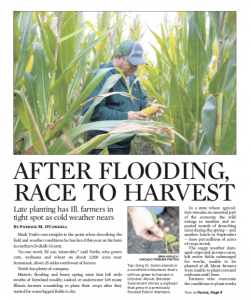
The Tribune article stated that,
The perils of a late harvest and the ramifications of lower-than-usual harvest numbers are significant. Illinois ranks No. 1 nationally for soybean production and No. 2 for corn (behind Iowa). Since many crops remain unharvested as Halloween approaches, farmers are hoping to avoid a frost, which can damage or destroy corn and soybeans still out in the field.
O’Connell added that, “Many crops, especially in the northern reaches of the state, have not yet reached maturity, farmers said. And as some of the crops reach maturity, the wet, mucky conditions make it difficult for farmers to bring their heavy harvesting equipment into the fields.”
Wall Street Journal writers Jacob Bunge and Kirk Maltais reported on Monday that, “Farmers who delayed planting in waterlogged fields this spring face a new threat as they race to harvest their crops: snow.
“Heavy snowfall and high winds over the past several days buffeted northern Farm Belt states where many farmers faced historic planting delays last spring. The early blizzard bookended a trying year for U.S. farmers. Crop prices generally remain under pressure because of high supplies and slackened demand as a result of the U.S.-China trade war. And many crops now threatened by a freeze are immature because they were planted so late.”
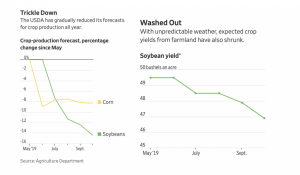
The Journal writers explained that, “The cold weather is a big threat to vulnerable crops. Only 22% of corn in North Dakota was mature as of Oct. 7, and 36% in South Dakota. In the 18 biggest corn-producing states, 58% of this year’s crop was mature, versus an average of 85% by that date over the previous five years, according to the USDA.
“Farmers in the Dakotas say the snow could delay their harvest by as much as three weeks. That will leave them scrambling to beat the next storm as colder weather advances. Some crops could go unharvested until next spring.”





